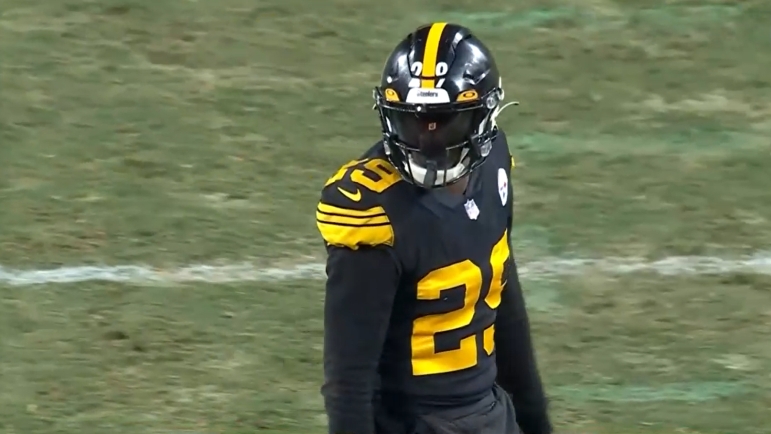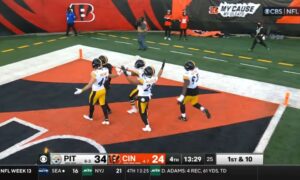Ahead of the 2023 off-season, re-signing Cameron Sutton, who was coming off a career year, seemed like a logical top priority for the Pittsburgh Steelers. Sutton signed with the Detroit Lions at the start of free agency and the front office immediately pivoted, signing a stopgap option in Patrick Peterson before double dipping in the draft with a pair of long-limbed corners. Pittsburgh’s new philosophy at the position places a clear emphasis on length and press-coverage ability.
Enter Levi Wallace, coming off a career year in his first season in Pittsburgh, and gifted with lengthy, 32 ¾” arms. After coming over from Buffalo, Wallace appeared in 15 games, starting 9 at the boundary cornerback position, while also playing extensively in sub-packages in games. Wallace finished with career highs in interceptions, with four, and passes defended, with 13. Despite not being among the league’s most dynamic athletes, the former UDFA drew heaps of praise from Nick Saban during his time at Alabama and brought an infusion of high-level communication and elite ball skills to Pittsburgh’s secondary.
While Pittsburgh’s front office ultimately chose to move on from Sutton in part due to a generational cornerback draft class, the move also shows faith in Wallace, and his ability to stabilize the secondary alongside his college teammate, Minkah Fitzpatrick. In today’s film room, we’ll be looking into some high-level reps that Wallace put on tape this past season, evaluating whether he can sustain his high-level play and turnover production in his second season in Pittsburgh.
As defensive backs in the modern Pittsburgh defense are asked to play man coverage at a higher rate than most teams leaguewide, it is important for corners to effectively mix up their pre-snap looks. A refined technician, Wallace is extremely comfortable playing from a traditional backpedal, routinely working hard to stay square even when his cushion is threatened.
Here, Wallace backs off pre-snap, getting to six yards depth before giving ground in his pedal, staying square, and sinking his hips to drive and contest the catch point. While Chris Olave ultimately secures an impressive contested catch, Wallace’s patience, efficiency in his transition, and route recognition skills are on display here. After setting a career high in passes defended last season, Wallace’s ability to consistently stay in phase to contest the catch point with physicality is equally impressive.
When evaluating defensive back play, I tend to try and focus on a player’s ability to consistently close and play the catch point. One of Wallace’s best traits as a player centers around his eye discipline, allowing him to maximize his efficiency closing to the catch point from out of phase.
Here, Wallace, responsible for the first vertical release to the boundary, plays from outside leverage, working into trail technique with Terrell Edmunds helping over the top. After allowing separation at the top of the route, Wallace plants and glues his eyes to the receiver’s hip, closing to get back into phase before turning to locate the ball, and laying out to disrupt the pocket and jar the football loose.
Although Pittsburgh tends to live in man free in obvious passing situations, it will mix in some 2-man under, allowing its corners to play more aggressively and undercut in/out breaking routes. Here, Wallace once again works to disguise his alignment pre-snap, aligning in a side-shuffle to bluff a quarters look before squaring up post snap, forcing an outside release, and assuming trail technique.
As the receiver declares inside at the top of the route, Wallace, using his vertical help defender to perfection, works to undercut the in-breaking route. Establishing contact with the near hip, he turns to locate the football and disrupts the catch point to produce a tip drill interception. His ability to disguise his alignment pre-snap before shifting to inside leverage disrupts the timing on this route, while his presence at the catch point helps to produce a takeaway opportunity in traffic. Simply put, this is teach tape on how to execute pre and post snap from a 2-man under look.
Coming out of college with a sub-par 40 time, Wallace has always profiled as a high-IQ player who excels in zone coverage assignments. What he lacks in raw athleticism, he makes up for in zone instincts, understanding of route combinations, and decisiveness in his reads to effectively cover ground.
Here, Wallace is working from a deep 1/3 assignment in a traditional country Cover 3 zone. Playing in the boundary, Wallace aligns with outside leverage on the #1 receiver, working to gain depth post snap before quickly diagnosing the #2 receiver releasing up the seam and taking a great angle to overlap and close the catch point. Ultimately, Wallace arrives in time to get his off arm across and secure the pass breakup.
Understanding that he has vertical help from the post safety, Wallace is able to take a flat angle to undercut the catch point, this time using zone eyes to close on the football rather than the receiver. Wallace’s effort on this play erases what was a perfect offensive play call to exploit the scheme and a well-timed ball from Andy Dalton. Once again, this is teach tape on how to overlap and play from depth as a Cover 3 corner.
Despite not having extraordinary height, Wallace’s unique frame, with elite arm length, allows him to mask his speed deficiencies and play effectively from press man coverage. At the snap, Wallace stays square, forcing a wide release before engaging his off-hand jam. Closing to the near hip, leaning and turning to locate the football, he uses his length to high point and secure an impressive interception at the catch point.
While his lack of top-end speed makes him a less than ideal matchup for certain receivers, Wallace’s comfortability in playing from the low shoulder gives him plenty of opportunities to secure takeaways at a solid rate. I would love to see him work with Joey Porter Jr., a player who thrives when squeezing routes from the top shoulder, to help him round out his game as he transitions to the next level.
Speaking of less-than-ideal matchups, there may be no receiver more capable of exploiting speed deficiencies than Tyreek Hill. While almost no corner is a good matchup for Hill on paper, Wallace’s lack of long speed was repeatedly attacked by the Miami coaching staff on over routes.
Here, Wallace does a nice job of staying square and weaving to maintain leverage but is ultimately no match to stay in phase as the speedy receiver works across the field. In the division, Zay Flowers is a player who Baltimore could utilize to similarly exploit this matchup.
With Miami working to ice the game and run out the clock, Wallace once again finds himself in an isolated matchup with Hill, this time aligning in press coverage in an attempt to disrupt timing. At the snap, Hill generates solid separation with a speed release, but Wallace once again shows great route recognition skills, taking a perfect angle to undercut and close to the catch point.
While the pass is late and inside, Wallace shows great eye discipline. Gluing his eyes to the near hip to maximize his efficiency in movement before turning to locate the football, he nearly secures a game-changing interception. My favorite aspect of this rep is Wallace’s ability to adapt and change his approach mid-game, using prior reps to bait the route and take a chance with the game on the line. Wallace’s ability to consistently close and arrive in phase at the catch point suggests that he has room to continue to improving his ball production.
Overall, much attention was given to the additions of Peterson, Porter, and Cory Trice Jr., and rightfully so. That being said, Wallace is going to need to continue to improve within the Steelers defensive scheme in year two, and ultimately, serve as the team’s best corner early in the season.
When targeted last season, Wallace allowed a 53.2% completion rate and a 73.0 passer rating, allowing three touchdowns but offsetting that with four interceptions to his credit. While his lack of top-end athleticism likely prevents him from ever ascending to elite corner status, his route recognition, patience in coverage, and elite ball skills make him an effective corner and a seamless fit in Pittsburgh’s takeaway-oriented defensive identity.
In an offseason with plenty of turnover on the back end of the Steelers’ defense, steady play from Wallace would go a long way in stabilizing the unit and building on a dominant finish that spurred a 7-2 record down the stretch. With his ability to consistently serve as a disruptive force at the catch point, don’t be surprised if Wallace is able to match or improve upon his ball production next season.








